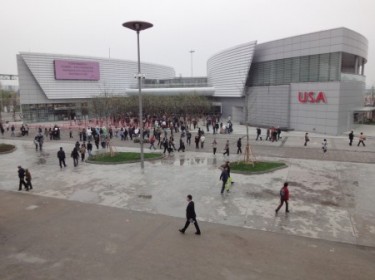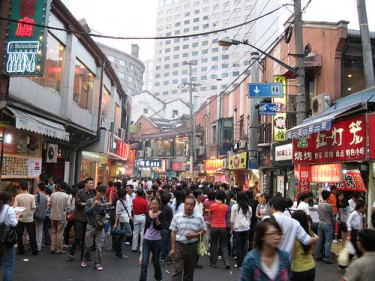The Shanghai World Expo is already two months in to its half-year residency. Bloggers have been active in trying to decipher the purpose of the extravaganza, as well as keep track of the lightning-speed developments few corners of Shanghai have been able to avoid in preparing for the event.
The exhibition, which opened on 1st May and will run until the end of October, has been seen as Shanghai's chance to showcase itself to the rest of the world. In dishing out the reported $46 billion spent on the Expo, China has invested more money in it than the 2008 Beijing Olympics. Official figures have predicted 70 million visitors will flock to the 240 pavilions and exhibitions staged by participating countries and organisations, spread out over 2.5 miles of Shanghai's Huangpu riverbank. Though initially, daily crowds were averaging at 200,000, as opposed to the 380,000 plus/day needed to hit the 70 million mark, 15th June saw a colossal 518,000 people attend, with some waiting between five and seven hours just to enter one pavilion.
The theme of the Expo, visible on posters, billboards and the ubiquitous Haibao mascot strewn across Shanghai, is ‘better city, better life’. Whether or not this slogan is an accurate reflection of the exhibition's effect on the city has been debated by Chinese netizens, not least among them being Han Han in his quintessentially derisive manner:
If you really want a metaphor, it’s sort of like when a domestic clothing brand is very hot and heavily advertised. You wear the clothes and feel badass and extravagant, but when you go abroad and ask around you discover it’s actually a second-rate brand.
The growing community of expat bloggers in China has also been vocal. Leading the pack for his widespread coverage is Shanghai-based American writer Adam Minter, who has documented the Expo on his reporter blog, Shanghai Scrap, for over a year. A major focus of Minter's reporting has been the detailed expose of the nepotism and corruption that occurred behind the construction site of the US pavilion, in particular.
City blogs such as Urbanatomy and Shanghaiist have also been following the daily comings and goings of the event, from the sly tactics eager visitors are using to enter pavilions to the online sale of souvenir Expo passports (complete with pavilion stamps) for a whopping 5,880 RMB ($840). The diligence of Shanghai's authorities in enhancing the aesthetic appeal of the 19 million-strong metropolis has also been noted: after years of construction, the landmark Bund walkway has been opened to pedestrians, luggage scanners have been planted in the stations of the city's ever-expanding metro system, the quintessential art of jaywalking has visibly withered, government-led programmes have encouraged residents to refrain from wearing pyjamas outside, and a restriction on knife sales has also been in place to maintain public security.
However, this Expo-inspired clean up of the city has also made room for widespread destruction of various historic neighbourhoods, which Paul French has covered (and promptly lamented) on China Rhyming. The characteristic Wujiang Lu food street, a gritty pathway of local dumpling houses and street skewer stalls, was entirely torn down and replaced with Western food chains and a mall in February.
Forced demolition and relocations, a common source of unrest in China and also a plague on the construction of the 2008 Beijing Olympics site, blasted into overdrive in preparation for the Expo. Both Minter and photographer Sue Anne Tay of Shanghai Street Stories documented the disappearance of Dongjiadu, one of Shanghai's oldest neighbourhoods, with residents being located to new apartments in the concrete jungle of Pudong New Area across the Huangpu River. In the words of Joe Benn, from Guangxi Master,
Shanghai is being painted as the utopian vision for a rapidly urbanizing Chinese population.
The perhaps archaic notion of an Expo or World's Fair has also left some bloggers questioning what the whole point of Shanghai's 2010 attempt is. C. Custer, of the bridge blog ChinaGeeks, writes,
the idea of a “World’s Fair” was understandably appealing in the 1800s, when it served as an important exchange point for technology, and its appeal continued in the twentieth century because of the peerless opportunity it provided to get a glimpse of lots of other cultures all in one place. Unfortunately, in the twentieth century, we have the internet for that. Many countries seem to be treating the Expo as a soft-power branding opportunity, and some countries are just phoning it in. But what seems to be missing from all this is why any regular person would really want to go. I’ve read far more coverage of the Expo than any average foreigner would be willing to, and it still seems like a collection of overly-stylized buildings containing vaguely interactive tourism advertisements. Why would I want to stand in line for hours for that?
The SHLaowai blog is equally skeptical:
the Expo is a big-time commercial circus money-making operation held under false and meaningless pretenses, sponsored by the world’s biggest corporations, held for no reason at all beyond the fact that there was one a couple years ago, and also a couple years ago before that, that, that, and that.
But optimistic outlooks are also hovering. Writing at Danwei, the author of the Chinayouren blog, Julen Madariaga, claims the Expo will be an unprecedented event in illustrating China's growing influence on the global stage. Its countrymen will also reap the benefits:
at a time when misunderstandings between cultures are rife, such events that promote communication and participation rather than passive spectator animosity can have a very real impact.
For many of them, the possibility of meeting all the different “foreign friends” classified by continent and country will be as exciting an any of the buildings in the Expo. Foreign visitors may be surprised when people take pictures of them as if they were walking pavilions.
For most Chinese it is extremely difficult to travel abroad, especially outside the South East Asian region. In spite of the number of foreigners concentrated in Beijing and Shanghai, for many inhabitants of smaller cities foreigners are still a novelty, and their cultures are greatly misunderstood. With the 3 day entrance passes set at relatively affordable prices, these people will flow into Shanghai en masse.
DeluxZilla's Zachary Franklin, who has been covering the Expo for the EU Press Wire Service, also took the opportunity to defend the event. Perhaps missing Minter's point in exposing the dark side of the US pavilion, Franklin disagrees with his fellow American, reminding us instead of how the hordes of Chinese visitors are enjoying the $61m construction, which includes films of personalities (including Kobe Bryant and Magic Johnson) attempting to speak to visitors in Chinese:
The Chinese do not care how the U.S. pavilion was built, where the money went or who got what in the process. This is a big generalization, but you haven’t seen any Chinese media clamoring over how the U.S. funded its pavilion or why it cost $61 million USD.
(…)
Even more important, the long lines in front of the U.S. pavilion are proof positive enough that there is a disconnect between what I’ve seen published about the American pavilion, and what is actually taking place at the site.
This quirky extravaganza of nation-branding that has accelerated Shanghai's development will continue for four more months. Expats are already witnessing the changes outside of the Expo grounds, and how these will continue come October 31st, after which all the pavilions will face the same demolition suffered by parts of old Shanghai, remains to be seen.
If you are interested in visiting the Expo, check out Adam Minter's guide of when to go, which pavilions to see and where to find a green patch to escape the crowds.












3 comments
Beijing was the world’s moment to look at China, the Expo is China’s moment to look at the world… It’s like a cheap trip around the world for those that can’t actually travel somewhere themselves. This is exemplified by the “passports” that people can pick up at the expo. You can get a “passport” and get stamped at each “country” you visit.
Anyways, I was pretty bored there, but the crowds around me seemed pretty content.
St. Lucia sent an exhibit, which as far as I understand is yet to completed and opened – from what I’ve heard, apparently construction of the area was not done properly and it seems there have been more important things for the Expo organizers than getting it ready.
So whatever money our government invested in showcasing St. Lucia, so far, has not so far, been worthwhile. We were encouraged to send goods – for business opportunities – but I couldn’t understand how in such a vast public oriented fair, we would make any connections – the sugar ant trying to get the attention of the mammoth…
The money spent on Shanghai’s frivolous Expo was money diverted that could be used and should be used for flood control, education for the poor, and affordable housing. Expo sort of grandeur is typical of Shanghai mentality — more show than substance. They want to show the Chinese their sophistication, and they want to show the Westerners that their Westernization. What they have managed to show, unfortunately, is arrogance to the Chinese and naivety to the Westerners.
Expo 2101 is a mess. It serves no social redeeming value and do so at the expense of rest of China. Like a rich man who spent all that big money and still got a lousy party.